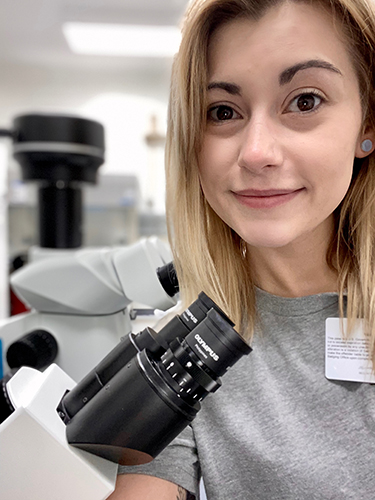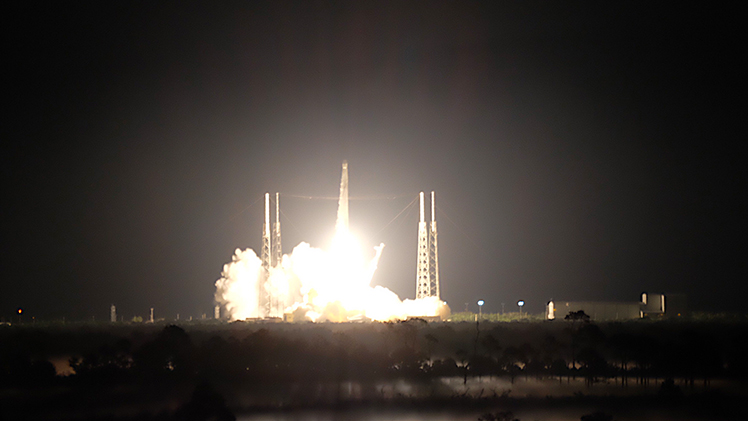Biochemists have long been working around a blind spot when it comes to proteins.
They know that hydrogen constitutes nearly half of the atoms in proteins, but how they contribute to protein function in these complex structures has been less clear. Hydrogen atoms are so small that traditional structural biology techniques cannot reveal their positions.

Dr. Victoria Drago, a post-doctoral research associate at Oak Ridge National Laboratory (ORNL) in Tennessee and recent UToledo alumna.
“So you’re missing half of the information,” said Dr. Victoria Drago, a post-doctoral research associate at Oak Ridge National Laboratory (ORNL) in Tennessee and recent alumna of The University of Toledo.
Not having a complete accounting of the locations of a protein’s hydrogen atoms is a conundrum with implications beyond the laboratory, including in structure-based drug design.
Drago began exploring a technique to pinpoint otherwise elusive hydrogens that involved growing protein crystals in microgravity as a graduate student alongside Dr. Timothy Mueser, a professor in the UToledo Department of Chemistry and Biochemistry. The analysis of those crystals — a chemistry term that in this case refers to the precise arrangement of the constituent atoms and molecules — is the basis of a recently published research article in the journal Cell Reports Physical Science.
“We used neutron diffraction,” said Drago, who is the lead author of the paper and who graduated with a doctorate in chemistry in 2022. “We were able to perform the experiment and achieve high resolution by leveraging microgravity to grow high-quality crystals of the enzyme.”
Neutron diffraction is a high-tech process that enables researchers to map out the precise locations of a molecule’s every single atom. It works to identify the locations of tiny hydrogen atoms, as with other atoms, but the signal is extremely weak in traditional structural biology techniques. That’s why they turned to microgravity, which enables the growth of larger and more perfectly structured crystals.
Drago, Mueser and their collaborators at ORNL and Institut Laue-Langevin, a leading nuclear research facility in Grenoble, France, sent solutions of the enzyme tryptophan synthase up for a one-month tour on the International Space Station in 2018, and again for a six-month journey in 2019 through 2020. The second trip yielded several very large, perfect crystals — many approximately one cubic millimeter, fivefold larger than those researchers grew in labs — which traveled for more than 50 million miles and survived a 9G splashdown in the Pacific Ocean.
Neutron diffraction proved successful on these crystals, allowing the researchers to reveal for the first time the active site hydrogens of the enzyme they chose to study.

Researchers sent solutions of the enzyme tryptophan synthase to the International Space Station for one month in 2018, and again for six months in 2019 through 2020. Photo courtesy of Dr. Victoria Drago.
Tryptophan synthase is scientifically valuable as a representative of a large and highly versatile family of enzymes that uses vitamin B6 for function. Because human beings do not produce tryptophan synthase, it’s also attractive to drug designers interested in leveraging the chemical structure of proteins in their development of new compounds to fight pathogenic microorganisms such as Salmonella enterica, Staphylococcus aureus and Mycobacterium tuberculosis.
“Victoria is a very talented researcher whose work at UToledo was instrumental in these findings,” Mueser said. “She fully took advantage of some wonderful opportunities while a student here, and her position at such a prestigious research facility as ORNL speaks to her hard work and her potential for continuing to make significant contributions in her field.”
Mueser’s lab is one of the growing population of scientific groups in the country working on neutron crystallography, and Drago has continued in this field at ORNL. She credits her unique experiences at UToledo with positioning her well for the specialized position.
“You can’t ask for more than the opportunity to do a post-doc at a national lab, especially at ORNL,” she said.